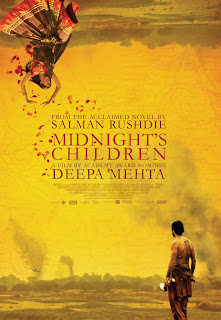“Kapringen” [A Hijacking] is already being celebrated with
major festival prizes worldwide. This
Danish film follows the arduous negotiating between the CEO of a cargo firm and
the Somali pirates who have captured the ship and crew. The sterile environment of the corporate
headquarters shot in bright antiseptic light contrasts with horrible conditions
the crew endures at the hands of gun crazy Muslim bandits. The room the crew is locked in is dark,
stuffy from lack of air and reeks of human excrement.
Days turn to weeks and eventually months as the bargaining
moves at a frustrating pace.
This is dark stuff with moral and ethical questions that
constantly leap from today’s headlines.
Just how much is human life worth; when is suffering too much?
One of my favorite books has finally been brought to the
screen. Salman Rushdie’s Midnight’s
Children follows the lives of two boys born at midnight on the eve of India’s
independence. One is born into wealth,
the other poverty but the babies are switched at birth and we are immersed in a
Fielding-esque satire of political upheaval, class warfare, and
oppression. The films handing of Rushdie’s
“magical realism” is lyrical and understated.
The caste is lovely to look at and the locations are gorgeously exotic and
claustrophobically decrepit. I read the
book so long ago that I don’t know if this is a valid recommendation but the
story came back to me in all its wondrous beauty.
The director was at the screening of Sweden’s “Call Girl”
and he introduced the film with the tongue-in-cheek observation that he was
surprised to see the theatre full at mid-day to watch a 2.5 hour movie about
the dark underbelly of Sweden. I sat
next to a Swedish woman connected to the industry and asked her why so many
Scandinavian films choose to examine the dark, the corrupt, the violent and
perverse. She thought for a moment and agreed
that was in fact the trend and it may be that they want to show that the region
is not all spic-and-span, not all blonde and beautiful, not the stereotyped
light and bright palette the region has been painted in since the 1950’s. “Call Girl” follows the trend set by the
Wallender stories, Steig Larssen, Sjöwall & Wahlöö, Jo Nesbo and others.
If we are to take anything away from this film, the government of
Sweden, it’s liberalism and quasi-socialist image exists as a means to hide the
reality that everyone is corrupt or corruptible. If you try to expose it you will be
dispatched before you open your mouth.
Trust no one and watch your back.
All this aside, the movie does portray a very believable scenario about
the recruitment of women and very young girls into the dead end life of the
call girl.
Cuba has
held my fascination for the past 20-odd years, since before my 1999 New Years’
celebration visit. This was the only
Cuban film at the Fest so I had to fit it in.
Lucy Mulloy wrote and directed her debut feature “Una Noche” about three
young people attempting to flee the limiting prospects of life in Havana. Her three leads are remarkably solid for
first time actors and we will see more of them I am certain. The Island is shot with affection, daily life
is portrayed in stark simplicity and there is very little political posturing. The enemy is not so much the government as
local law enforcement. The scenes shot
on and in the water are impressive for a low budget freshman effort.





No comments:
Post a Comment